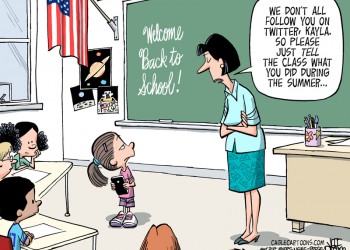As education speakers and teaching trends experts have pointed out: Although some states and school districts have taken steps to ban private relationships between teachers and students on social networks, there are still many ways in which social networks can help in a classroom setting, when used appropriately.
In fact, social networks can be a driving force for good in education, as teachers can use it to teach about digital citizenship, current events and even help with research.
Here’s a look at how education speakers and teaching trends consultants say that educators can benefit from social networks, and some specific ideas on how they can use it:
Improved Educational Benefits – The power of digital networks is in the ability to connect learners and teachers across space and institutional boundaries, to build linkages between school, home and community, and to make information and learning resources highly accessible and personalized. Dr. Paula Tallal, professor of neuroscience at Rutgers University, says that “social media is training us for the environment we live in now,” noting that it’s a great tool for building communities where none existed before. Tallal gives the example of kids texting or tweeting about a class or lecture, and then forming study groups based on these interactions.
Enhanced Social Awareness – Although there’s a perception among many that social networks are really just a bunch of people saying “look at me,” research shows that nearly half of all teens who use Facebook are more cause-oriented because of social networks. It could be as simple as liking a charity or following them on Facebook, but often kids are at the forefront of spreading and disseminating videos and information that have a global focus.
Promotion of Charitable Efforts – A recent study from World Vision showed that social media is opening teens’ eyes and increasing their engagement with many charitable causes. Nearly half of all girls on social networks are apt to “like” or “follow” charity pages and accounts, while just less than a third of boys do the same. Kids are likewise using social networks to kick-start their own funding campaigns and causes. A college student was able to raise more than $150,000 for relief for Haiti by simply creating an event on Facebook asking for donations and sharing it with friends and family. And a seven-year-old boy in the UK named Charlie Simpson organized a five-mile bike to raise more than $80,000 for the same cause.
Heightened Civic Engagement – Like you might have heard several education speakers point out, a recent survey from the MacArthur Foundation’s Research Network on Youth and Participatory Politics found that social media services are playing a “crucial role” in the trend of 15-25 year olds participating in civic life. This observation is particularly interesting because by traditional standards, this group is judged to be the least involved in participatory politics. What this information indicates is that, as parents, we need to rethink the ways that social media can influence the way our kids live their lives.
Better Community Building – Many kids have unique interests, and while they may struggle to find others with similar interests in their schools, chances are they can find a thriving and passionate base of like-minded fellows via social networks. These connections help prevent kids from feeling isolated. Social media sites are also expanding from general interest topics to more specific uses that benefit society. For example, sites have been created for medical purposes such as dealing with life-altering diseases, alcoholism, drug addiction, weight loss, and autism. Social networking sites with a specific focus help introduce people to others who are dealing with similar issues and provide information, contacts, peer support, and encouragement.
How can teachers use social networks in a way that will benefit the class? Here are three ways that education speakers recommend taking advantage of this technology:
Create a Classroom Page On Facebook – Use this as a hub to connect with and communicate with students about class projects, subject matter and even homework assignments. Teachers can be the admin of the group and control who can join and who can post.
Use Pinterest for Classroom Ideas – Create a board on Pinterest and use it to collect ideas for classroom activities, or images of ongoing programs and projects for sharing.
Provide a Parental Communication Hub – Sites like Shutterfly offer a way for parents to connect to one central location to post information about class activities or field trips, showcase pictures and more. It’s a quick, easy way for many to communicate efficiently.
GET YOUR FREE COPY NOW!
books
Limited-Time Offer: Download Free eBook THINK SMARTER Today!
No spam. We respect your privacy.














